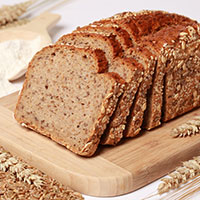| Vitamin name |
Folic Acid |
| What’s it used for? | Co-factor in many enzyme systems, prevention of neural tube defects during pregnancy, formation of red blood cells |
| Best food sources | Green leafy vegetables, corn, sweet potatoes, whole wheat bread, oranges and berries |
| How much do I need? | NRV is 200 µg per day* |
| Need to know | Folic acid is very sensitive and is easily destroyed by light, heat, cooking and storage |
*A Nutrient Reference Value or NRV is the recommended level set by the UK Department of Health for daily nutrient intake
Folic Acid
Folic acid, or Vitamin B9, is a member of the water-soluble family of B vitamins and was apparently so-called because of the Latin word ‘folium’, meaning foliage. This is because it is abundant in green leafy vegetables.
It’s also known as folate, which is the natural form found in foods. Folic acid is the synthetic form normally used in food supplementation. It is converted into its active form called tetrahydrofolic acid in the liver.
Why do I need it?
Folic acid acts as a co-enzyme for a number of key functions. One of its most important is in the prevention of neural tube defects in the unborn baby, during pregnancy. This is because it’s key in the division of cells in the body. Public Health England recommend women take 400 µg of folic acid for three months prior to conception and for at least the first trimester of pregnancy.
Folic acid is key in brain and nerve development and functioning and also appears to have a protective effect on the heart and brain. This is partly because folic acid works in conjunction with vitamin B6 and vitamin B12 in reducing homocysteine levels – a potential measure of heart disease and Alzheimer’s disease.
Folic acid actually works in similar ways to vitamin B12 in the formation of red blood cells; large doses of folic acid can often mask a deficiency of B12, therefore the two nutrients ideally need to be in balance.
Best food sources
Folate is the natural form of vitamin B9 found in foods. It is widely available in many different foods particularly any green vegetables.
Foods high in Folic Acid

Spinach – 194 µg per 100g

Asparagus – 149 µg per 100g

Bread (wholewheat) – 85 µg per 100g

Collard greens – 50 µg per 100g

Oranges – 39 µg per 100g
Are you getting enough?
Folic acid deficiency can manifest itself in the same way as vitamin B12 deficiency; symptoms such as low energy, weight loss, and heart palpitations can occur. It is also possible to get folic acid anaemia where the red blood cells show up as large and irregular. This can also be masked by taking large doses of vitamin B12. However, this is correctable by increasing intake of folic acid.
Possible clinical uses include depression, fatigue, skin problems and poor appetite. Requirements for folic acid increase during pregnancy.
Did you know?
Folic acid is easily destroyed, making low levels in the body more likelyIt can, however, be stored in the liver for six to nine months before deficiencies occur
It is also depleted by stress, alcohol, taking hormonal drugs and anti-epileptic medication
Folic Acid is safe and advised to take during pregnancy and breastfeeding at the recommended dosages – speak to your healthcare professional for further advice
For all the latest research on folic acid click here
Try this
Folic Acid is found in the Alive! range of multi vitamins and minerals.
For more information visit www.feelaliveuk.com
You can also follow Alive! on Twitter for general health and wellbeing tips: @feelaliveuk







